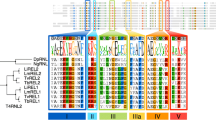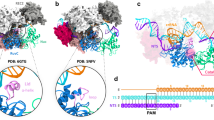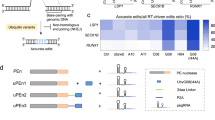Abstract
Kinetoplastid RNA editing ligases 1 and 2 (KREL1 and KREL2) share a significant degree of sequence homology. However, biochemical experiments have reported that KREL1 and KREL2 differ in their functional roles during the RNA editing process. In this study, we hypothesize that dissimilar roles for KREL1 and KREL2 proteins arise from their different physicochemical characteristics. To test our hypothesis at sequence level, we plotted theoretical titration curves for KREL1, KREL2 and their binding partner proteins. The plots showed a lower isoelectric point for KREL1 compared to that for KREL2 as well as more relative alkalinity and acidity for binding partner proteins of KREL1 and KREL2 at net charge zero, respectively. At structure level, based on the available high resolution structure of KREL1 N-terminal domain and strong sequence similarity between KRELs and other ligases, we built the homology model of KREL2 N-terminal domain. Using Poisson-Boltzmann continuum approach, we calculated the electrostatic potential isosurfaces of KREL1 structure and KREL2 model. KREL1 and KREL2 coordinates differed in their electrostatic isopotential patterns. A wider negative patch on the surface of KREL1 suggests differential affinity for another protein compared to KREL2. In contrast, a larger positive patch on the KREL2 surface predicts its differential affinity and/or specificity for its RNA substrate. Subsequently, we employed in silico mutational scanning and identified the surface-exposed residues contributing to the long-range electrostatic energy of KRELs. We predict that two structurally conserved loops of KRELs, not previously reported in the literature, also recognize their RNA substrates. Our results provide important information about the physicochemical properties of RNA editing ligases that could contribute to the ligation step of RNA editing.
















Similar content being viewed by others
References
Schnaufer A, Domingo GJ, Stuart KD (2002) Natural and induced dyskinetoplastid trypanosomatids: how to live without mitochondrial DNA. Int J Parasitol 32(9):1071–1084
Matthews KR (2005) The developmental cell biology of Trypanosoma brucei. J Cell Sci 118(2):283–290
Benne R (1993) RNA editing: the alteration of protein coding sequences of RNA. Horwood, New York
Horvàth A, Berry EA, Maslov DA (2000) Translation of the edited mRNA for Cytochrome b in Trypanosome Mitochondria. Science 287(5458):1639–1640
Horváth A, Kingan TG, Maslov DA (2000) Detection of the mitochondrially encoded Cytochrome c oxidase subunit I in the Trypanosomatid Protozoan Leishmania tarentolae. Evidence for translation of unedited mRNA in the kinetoplast. J Biol Chem 275(22):17160–17165
Blum B, Bakalara N, Simpson L (1990) A model for RNA editing in kinetoplastid mitochondria: RNA molecules transcribed from maxicircle DNA provide the edited information. Cell 60:189–198
Simpson L, Aphazizhev R, Gao G, Kang X (2004) Mitochondrial proteins and complexes in Leishmania and Trypanosoma involved in U-insertion/deletion RNA editing. RNA 10(2):159–170
Lukeš J, Hashimi H, Zíková A (2005) Unexplained complexity of the mitochondrial genome and transcriptome in kinetoplastid flagellates. Curr Genet 48(5):277–299
Stuart K, Schnaufer K, Ernst NL, Panigrahi AK (2005) Complex management: RNA editing in trypanosomes. Trends Biochem Sci 30(2):97–105
Aphasizhev R (2007) RNA editing. Mol Biol 41(2):227–239
Aphasizhev R, Aphasizheva I, Nelson RE, Simpson L (2003) A 100-kD complex of two RNA-binding proteins from mitochondria of Leishmania tarentolae catalyzes RNA annealing and interacts with several RNA editing components. RNA 9(1):62–76
Vondrušková E, van den Burg J, Zíková A, Ernst NL, Stuart K, Benne R, Lukeš J (2005) RNA interference analyses suggest a transcript-specific regulatory role for mitochondrial RNA-binding Proteins MRP1 and MRP2 in RNA editing and other RNA processing in Trypanosoma brucei. J Biol Chem 280(4):2429–2438
Schumacher M, Karamooz E, Zíková A, Trantírek L, Lukeš J (2006) Crystal structures of T. brucei MRP1/MRP2 guide-RNA binding complex reveal RNA matchmaking mechanism. Cell 126(4):701–711
Panigrahi AK, Gygi SP, Ernst NL, Igo RP Jr, Palazzo SS, Schnaufer A, Weston DS, Carmean N, Salavati R, Aebersold R, Stuart KD (2001) Association of two novel proteins, TbMP52 and TbMP48, with the Trypanosoma brucei RNA editing complex. Mol Cell Biol 21(2):380–389
Rusché LN, Huang CE, Piller KJ, Hemann M, Wirtz E, Sollner-Webb B (2001) The two RNA ligases of the Trypanosoma brucei RNA editing complex: cloning the essential band IV gene and identifying the band V gene. Mol Cell Biol 21(4):979–989
McManus MT, Shimamura M, Grams J, Hajduk SL (2001) Identification of candidate mitochondrial RNA editing ligases from Trypanosoma brucei. RNA 7(2):167–175
Cruz-Reyes J, Zhelonkina AG, Huang CE, Sollner-Webb B (2002) Distinct functions of two RNA ligases in active Trypanosoma brucei RNA editing complexes. Mol Cell Biol 22(13):4652–4660
Worthey EA, Schnaufer A, Mian IS, Stuart K, Salavati R (2003) Comparative analysis of editosome proteins in trypanosomatids. Nucl Acids Res 31(22):6392–6408
Palazzo SS, Panigrahi AK, Igo RP Jr, Salavati R, Stuart K (2003) Kinetoplastid RNA editing ligases: complex association, characterization, and substrate requirements. Mol Biochem Parasito 127(2):161–167
Gao G, Simpson AM, Kang X, Rogers K, Nebohacova M, Li F, Simpson L (2005) Functional complementation of Trypanosoma brucei RNA in vitro editing with recombinant RNA ligase. Proc Natl Acad Sci U S A 102(13):4712–4717
Schnaufer A, Panigrahi AK, Panicucci B, Igo RP Jr, Salavati R, Stuart K (2001) An RNA ligase essential for RNA editing and survival of the bloodstream form of Trypanosoma brucei. Science 291(5511):2159–2162
Huang CE, Cruz-Reyes J, Zhelonkina AG, O’Hearn S, Wirtz E, Sollner-Webb B (2001) Roles for ligases in the RNA editing complex of Trypanosoma brucei: band IV is needed for U-deletion and RNA repair. The EMBO J 20(17):4694–4703
Drozdz M, Palazzo SS, Salavati R, O’Rear J, Clayton C, Stuart K (2002) TbMP81 is required for RNA editing in Trypanosoma brucei. EMBO J 21(7):1791–1799
Gao G, Simpson L (2003) Is the Trypanosoma brucei REL1 RNA ligase specific for U-deletion RNA editing, and is the REL2 RNA ligase specific for U-insertion editing? J Biol Chem 278(30):27570–27574
Deng J, Schnaufer A, Salavati R, Stuart KD, Hol GJ (2004) High resolution crystal structure of a key editosome enzyme from Trypanosoma brucei: RNA editing ligase 1. J Mol Biol 343(3):601–613
Schnaufer A, Ernst NL, Palazzo SS, O’Rear J, Salavati R, Stuart K (2003) Separate insertion and deletion subcomplexes of the Trypanosoma brucei RNA editing complex. Mol Cell 12(2):307–319
Murzin AG (1993) OB(oligonucleotide/oligosaccharide binding)-fold: common structural and functional solution for non-homologous sequences. EMBO J 12(3):861–867
Doherty AJ, Suh SW (2000) Structural and mechanistic conservation in DNA ligases. Nucleic Acids Res 28(21):4051–4058
Amaro RE, Swift RV, McCammon JA (2007) Functional and structural insights revealed by molecular dynamics simulations of an essential RNA editing ligase in Trypanosoma brucei. PLoS Negl Trop Dis 1(2):e68
Kang X, Gao G, Rogers K, Falick AM, Zhou S, Simpson L (2006) Reconstitution of full-round uridine-deletion RNA editing with three recombinant proteins. Proc National Academy of Sciences 103(38):13944–13949
Berman HM, Westbrook J, Feng Z, Gilliland G, Bhat TN, Weissig H, Shindyalov IN, Bourne PE (2000) The protein data bank. Nucleic Acids Res 28(1):235–242
Henderson LJ (1908) Concerning the relationship between the strength of acids and their capacity to preserve neutrality. Am J Physiol 21(4):173–179
Hasselbalch KA (1917) Die Berechnung der Wasserstoffzahl des Blutes aus der freien und gebunden Kohlensäure desselben, und die Sauerstoffbindung des Blutes als Funktion der Wasserstoffzahl. Biochemische Zeitschrift 78:112–144
Olmsted JB (1986) Microtubule-associated proteins. Annu Rev Cell Biol 2(1):421–457
Bloom GS, Endow SA (1994) Motor proteins. 1: kinesins. Protein Profile 1(10):1059–1116
Altschul SF, Madden TL, Schaffer AA, Zhang J, Zhang Z, Miller W, Lipman DJ (1997) Gapped BLAST and PSI-BLAST: a new generation of protein database search programs. Nucleic Acids Res 25(17):3389–3402
Henikoff S, Henikoff JG (1992) Amino acid substitution matrices from protein blocks. Proc Natl Acad Sci U S A 89(22):10915–10919
Edgar RC (2004) MUSCLE: a multiple sequence alignment method with reduced time and space complexity. BMC Bioinformatics 5(1):113
Michener CD, Sokal RR (1957) A quantitative approach to a problem in classification. Evolution 11(2):130–162
Sneath PHA, Sokal RB (1973) Numerical taxonomy: the principles and practice of numerical classification. W.H. Freeman, San Francisco
Notredame C, Higgins DG, Heringa J (2000) T-Coffee: a novel method for fast and accurate multiple sequence alignment. J Mol Biol 302(1):205–217
Katoh K, Misawa K, Kuma K, Miyata T (2002) MAFFT: a novel method for rapid multiple sequence alignment based on fast Fourier transform. Nucleic Acids Res 30(14):3059–3066
Šali A, Blundell TL (1993) Comparative protein modelling by satisfaction of spatial restraints. J Mol Biol 234(3):779–815
Shen MY, Šali A (2006) Statistical potential for assessment and prediction of protein structures. Protein Sci 15(11):2507–2524
Lüthy R, Bowie JU, Eisenberg D (1992) Assessment of protein models with three-dimensional profiles. Nature 356(6364):83–85
Kabsch W, Sander C (1983) Dictionary of protein secondary structure: pattern recognition of hydrogen-bonded and geometrical features. Biopolymers 22(12):2577–2637
Klapper I, Hagstrom R, Fine R, Sharp K, Honig B (1986) Focusing of electric fields in the active site of Cu-Zn superoxide dismutase: effects of ionic strength and amino-acid modification. Proteins: Structure, Function, Genetics 1(1):47–59
Gilson MK, Honig B (1988) Calculation of the total electrostatic energy of a macromolecular system: solvation energies, binding energies, and conformational analysis. Proteins: Structure, Function, Genetics 4(1):7–18
Nicholls A, Honig B (1991) A rapid finite difference algorithm, utilizing successive over-relaxation to solve the Poisson-Boltzmann equation. J Comp Chem 12(4):435–445
Rocchia W, Alexov E, Honig B (2001) Extending the applicability of the nonlinear Poisson-Boltzmann equation: multiple dielectric constants and multivalent ions. J of Phys l Chem B 105(28):6754–6754
Halgren TA (1996) Merck molecular force field. I. Basis, form, scope, parameterization, and performance of MMFF94. J Comp Chem 17(5 & 6):490–519
Halgren TA (1996) Merck molecular force field. II. MMFF94 van der Waals and electrostatic parameters for intermolecular interactions. J Comp Chem 17(5 & 6):520–552
Halgren TA (1996) Merck molecular force field. III. Molecular geometries and vibrational frequencies for MMFF94. J Comp Chem 17(5 & 6):553–586
Halgren TA, Nachbar RB (1996) Merck molecular force field. IV. Conformational energies and geometries for MMFF94. J Comp Chem 17(5 & 6):587–615
Halgren TA (1996) Merck molecular force field. V. Extension of MMFF94 using experimental data, additional computational data, and empirical rules. J Comp Chem 17(5 & 6):616–641
Halgren TA (1999) MMFF VI. MMFF94s option for energy minimization studies. J Comp Chem 20(7):720–729
Halgren TA (1999) MMFF VII. Characterization of MMFF94, MMFF94s, and other widely available force fields for conformational energies and for intermolecular-interaction energies and geometries. J Comp Chem 20(7):730–748
Blomberg N, Gabdoulline RR, Nilges M, Wade RC (1999) Classification of protein sequences by homology modeling and quantitative analysis of electrostatic similarity. Proteins: Str, Function Genetics 37:379–387
Wade RC, Gabdoulline RR, DeRienzo F (2001) Protein interaction property similarity analysis. Int J Quant Chem 83:122–127
Wade RC, Gabdoulline RR, DeRienzo F (2007) qPIPSA: relating enzymatic kinetic parameters and interaction fields. BMC Bioinformatics 8:373
Richter S, Wenzel A, Stein M, Gabdoulline RR, Wade RC (2008) webPIPSA: a web server for the comparison of protein interaction properties. Nucleic Acid Res,Web server early access, 36:W276ÐW280
Hodgkin EE, Richards WG (1987) Molecular similarity based on electrostatic potential and electric field. Int J Quant Chem Quant Biol Symp 14:105–110
Kortemme T, Kim DE, Baker D (2004) Computational alanine scanning of protein-protein interfaces. Sci STKE 2004(219):pl2
Acknowledgements
We thank the members of the Salavati laboratory for their discussion and critical reading of the manuscript. We also thank Prof. Enrico O. Purisima (National Research Council of Canada) for valuable comments. Research at the Institute of Parasitology is supported by the Centre for Host-Parasite Interactions and Le Fonds québécois de la recherche sur la nature et les technologies (FQRNT), Quebec. This research is supported by the National Sciences and Engineering Research Council of Canada (NSERC) grant #328186 and Leaders Opportunity Fund (LOF) grant #12573 to R.S.
Author information
Authors and Affiliations
Corresponding author
Electronic Supplementary Material
Below is the link to the electronic supplementary material.
ESM 1
(TXT 167 kb)
Supplementary Figure
The electrostatic potential dendeogram (epogram) of the modeled TbREL2 and the crystal structure of TbREL1 (PDB:1XDN). The clusters are bound in red boxes. The best model is labeled as “TbREL2 N-terminal model” (DOC 32 kb).
Figure 1
(EPS 163 kb).
Figure 2
(PS 156 kb).
Rights and permissions
About this article
Cite this article
Shaneh, A., Salavati, R. Kinetoplastid RNA editing ligases 1 and 2 exhibit different electrostatic properties. J Mol Model 16, 61–76 (2010). https://doi.org/10.1007/s00894-009-0506-1
Received:
Accepted:
Published:
Issue Date:
DOI: https://doi.org/10.1007/s00894-009-0506-1




